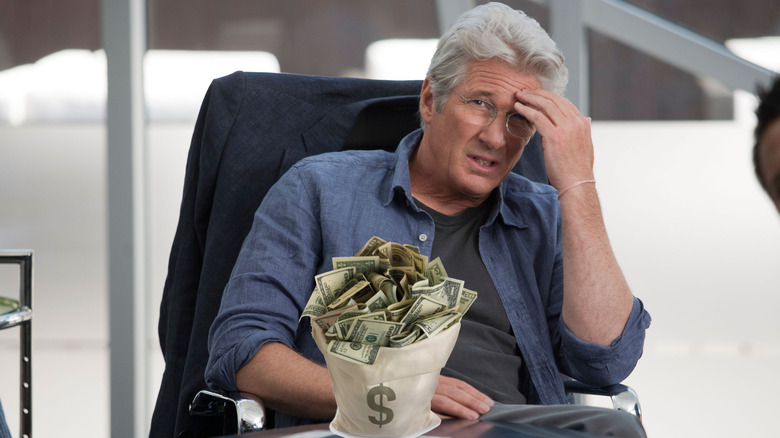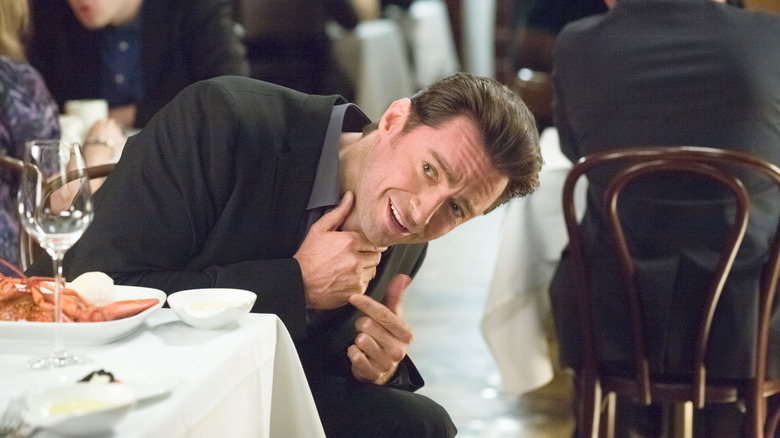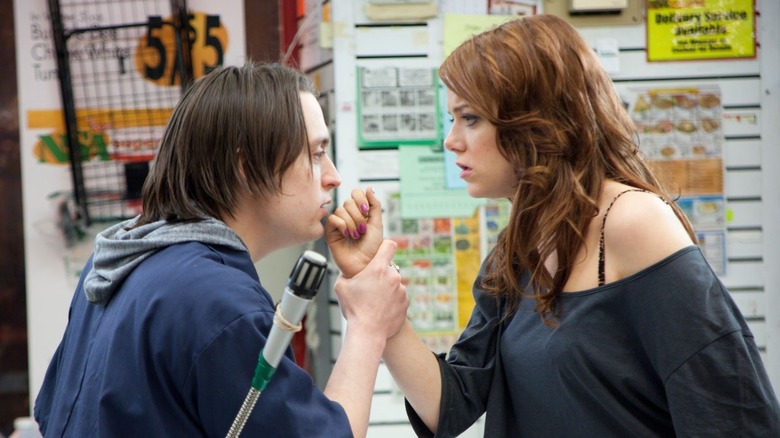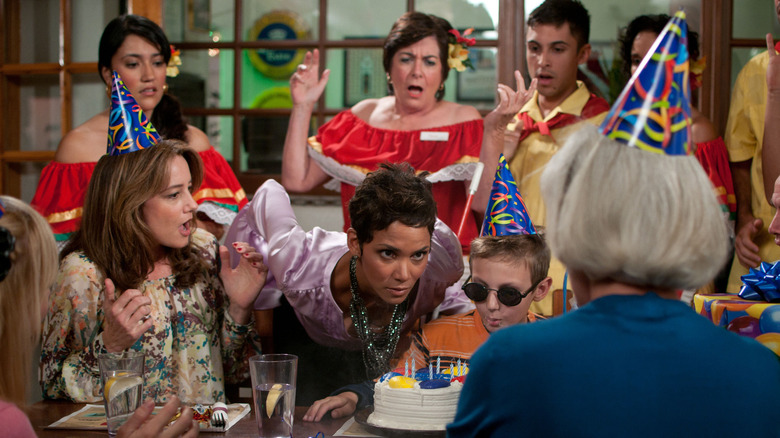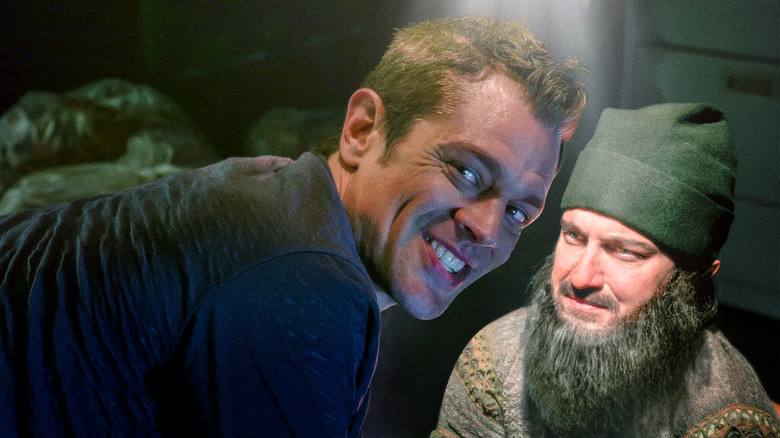Tales From The Box Office: Movie 43 Was An Epic Disaster ... Or Was It?
(Welcome to Tales from the Box Office, our column that examines box office miracles, disasters, and everything in between, as well as what we can learn from them.)
There are, and always will be, movies that critics hate. It's just the nature of the beast as it exists. And let's be fair, general audiences oftentimes simply disagree with critics. Just look at the fact that "Venom" made a stunning $856 million at the global box office against pretty terrible reviews. To put it simply, it do be like that sometimes. But then there is the occasional movie that is perceived to be so bad, it almost instantly etches itself into the annals of cinema history in the most unflattering way possible. Enter 2013's "Movie 43," a comedy with staggeringly abysmal reviews and an equally staggering, star-studded cast that stunned Hollywood with its awfulness. Again, if the reviews are to be believed.
The movie was the brainchild of producer Charles B. Wessler, who had been kicking around the idea for years with no success in terms of getting it made. The idea? Put together a feature-length collection of sketches and clips of the raunchy and outrageous variety, with as many famous people as possible anchoring the whole thing down. The result? One of the most reviled studio movies of the last 20 years. Yet, it's one that actually may have, in the end, become a modest success anyhow.
In honor of the movie's tenth anniversary, we're looking back at "Movie 43," how it finally got made, how it managed to put together that insane ensemble cast, what happened when it actually hit theaters, and what we can learn from it a decade later. Let's dig in, shall we?
The movie: Movie 43
When the film was first coming together, without its title (we'll get to that), Wessler assembled an impressive list of directors in Trey Parker and Matt Stone ("South Park"), Peter and Bob Farrelly ("Dumb and Dumber"), and David and Jerry Zucker ("Airplane!) to direct the various segments. All but the Farrelly brothers eventually dropped out. Many others, such as Elizabeth Banks and James Gunn would eventually fill in, even if Gunn didn't exactly have kind things to say about it after the fact. "I didn't even get to edit that stupid thing!" the now-co-head of DC Studios said on a Facebook live.
Wessler was still determined, despite things not going very well. At one point, he even had a studio bail well into negotiations. "They ended up calling me about a month after we started negotiating the deal and said 'we can't do it' because they had political pressure to not make R-rated movies that were marketed to teenagers," he told The Hollywood Reporter in 2013. Then, finally, he managed to cut a deal with Relativity Media. How, exactly? By showing them a particularly raunchy short (the first one shot for the film), in which Hugh Jackman goes on a date with Kate Winslet — and he's got a literal set of testicles drooping from his chin.
"They just looked at me and said, 'Go for it.' It takes a lot of balls to make something that is not conventional," Wessler told THR. And so, it was off to the races. Though it would take patience, in large part because they had to assemble a downright silly cast that includes (but is not limited to) Dennis Quaid, Naomi Watts, Liev Schreiber, Anna Faris, Chris Pratt, Johnny Knoxville, Gerard Butler, Emma Stone, Halle Berry, Terrence Howard, and many, many more.
Not taking no for an answer
"Most agents would avoid me because they knew what I wanted to do — what agent wants to book their big client in a no pay, $800-a-day, two-day shoot?" Wessler explained at the time. "The truth is, I had a lot of friends who were in this movie. And if they didn't say yes, this movie wouldn't have gotten made." As he told it, the actors were mostly willing to do it because it let them play outside of their typical wheelhouse. Wolverine by day, guy with balls on your chin by night, as it were. Peter Farrelly also explained to the New York Post in 2013 that they had to get creative when it came to actually getting these agreements to stick. "They clearly wanted out," he said, "but we wouldn't let them. Wait for them. Shoot them when they want to shoot. Guilt them to death."
In the end, it took four years to cobble the whole thing together, waiting for various actors' schedules to clear up. Richard Gere was, in particular, tough to wrangle, but he eventually agreed under several conditions, including getting it done in just four days. And so it went. Fortunately, it was the kind of movie that one could pick up with as people became available. Shoot what you can, wait until the guilt lines up with the timing. Not everyone said yes, however, with the likes of Colin Farrell and George Clooney turning it down. Clooney, in particular, reportedly said, "No f***ing way."
As for the seemingly nonsensical title? It's nonsense and means nothing. Farrelly apparently heard his son speaking with some friends about a film called "Movie 43." Yet, upon further inspection, he discovered that such a film didn't exist. So he took the name, and thus, this collection of R-rated, low-brow sketches had something to go by.
The financial journey
Typically, a movie with a cast with a tenth of this star power would enter theaters with a tidal wave of promotion. But in this case, no one from the impressive ensemble promoted the film in any meaningful way. Yes, Relativity released a trailer, but beyond that, it was close to radio silence. Be that as it may, "Movie 43" was released domestically on January 25, 2013 to downright scathing reviews. To date it carries a mere 4% approval rating on Rotten Tomatoes, with a meager 24% audience score.
Can critics be blamed for not going to bat for a sketch that involves Naomi Watts and Liev Schreiber homeschooling their kid in creepy fashion? Or one where Chris Pratt takes a dump on Anna Faris' chest? Naturally, with little promotion and not much of a marketing campaign to speak of, the film disappointed in theaters, taking in just $4.8 million on its opening weekend, placing at number seven on the charts. It dropped off a cliff the following weekend, dropping more than 65% and earning just $1.6 million. So it was a disaster ... right?
Well, not so fast. In the end, the film took in $8.8 million domestic and, rather surprisingly, $23.5 million internationally for a grand total of $32.4 million. Plus, the budget was just $6 million, since the stars were paid very little for their time. Not only that, but Relativity managed to cover the entirety of the budget through foreign presales and a deal with Netflix. So, for the most part, anything beyond recouping the minimal marketing spend was profit — even if some of the stars were surely entitled to a cut.
The lessons contained within
It is, in some cases, difficult to look for something of value in the case of something so reviled by so many. This is a movie that its stars rejected in its day, that audiences roundly decided they didn't care about, and that most major studios ran away from. It is, by most measures, an embarrassment. Then again, it probably actually managed to make some money for Relativity, the only studio that saw an opportunity here, even though the widespread perception was one of failure.
There is then, perhaps, a lesson in relativity as it relates to the movie business. Sure, a movie can be perceived widely as a failure, in no small part due to loud hatred of the movie in question. Just look at 2016's "Suicide Squad," a movie many would probably label as "bad" that made $746 million at the box office and, perhaps even more amazingly, won an Oscar. There's also "Transformers: Age of Extinction" ($1.1 billion), and low-brow fare such as "Paul Blart: Mall Cop" ($183 million) and "Grown Ups" ($271 million). The list goes on. And they can be successful business ventures despite whatever perception may exist.
The point is, numbers, in the end, may not tell the whole story, but they don't lie either. So sure, in its day, "Movie 43" could have been looked at as a disaster and, in what little reflection there is on the largely forgotten picture, it can still be viewed as a tasteless piece of cinema. Be that as it may, it made well over five times its production budget with next to no risk on the part of the studio. That, by any studio's definition, is probably considered to be good business — perception be damned.
